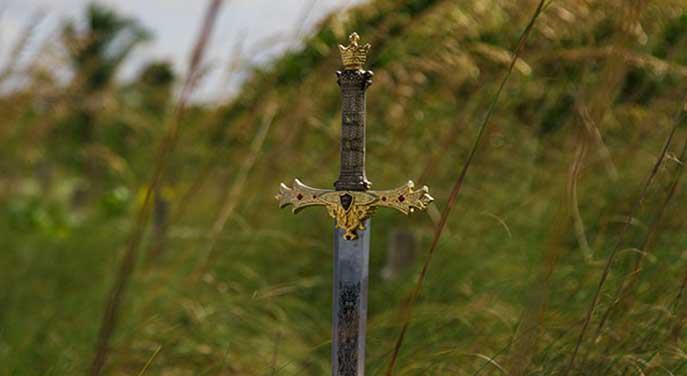 King Arthur is back in the news, thanks to an archeological dig in Herefordshire, England.
King Arthur is back in the news, thanks to an archeological dig in Herefordshire, England.
The dig site in question is Arthur’s Stone, a Neolithic-era burial chamber that’s somewhere in the vicinity of 4,000 years old. It’s technically a dolmen with a capstone resting on nine uprights. And with an estimated weight of around 25 tonnes, the capstone is sufficiently large to (once again) raise the question of how prehistoric people managed to construct such edifices.
But the fellow leading the project has no expectations of finding anything related to Arthur. Like many other locations scattered around Britain, the Arthurian connection is fanciful. Probably the same can be said for the man himself.
Whether Arthur ever existed is indeed historically debatable. Perhaps the best case for him is of the no-smoke-without-fire variety. Persistent long-lived legends shouldn’t be lightly dismissed. Maybe characters like Arthur are a composite of actual people with the narrative embroidered and tailored over the centuries.
The written origins of Arthur’s legend can be traced to the sixth-century monk Gildas, who told the story of a local Romano-Celtic king, Ambrosius Aurelianus, and his victory over invading Saxons at the Battle of Badon. Later renditions introduced the character of Arthur as a hero in the battle, and Geoffrey of Monmouth’s 12th-century opus, The History of the Kings of Britain, put the whole thing on steroids.
From there, bits and pieces were added.
French writer Chretien de Troyes injected the elements of chivalry, tournaments and the search for the Holy Grail, while Sir Thomas Malory’s 15th-century rendering gave us the version we’re most familiar with. Along with idealism, vigorous battles and daring deeds, we get adultery and destruction, betrayal and repentance.
Although it may be a fabrication, the story has powerful resonance.
|
Related Stories |

|
| King Arthur and the crafty monks of Glastonbury
|
| Everything I know about the U.K. I learned from TV
|
| If you like medieval drama, The Last Kingdom fits the bill
|
Filmmakers have long loved it and the cast of characters is pure catnip for dramatists. You have the noble Arthur, his unfaithful wife Guinevere, her lover – and Arthur’s best friend – Lancelot, the magician Merlin and the traitorous Mordred.
MGM’s 1953 offering, Knights of the Round Table, was my first cinematic exposure. Featuring Robert Taylor as Lancelot, Ava Gardner as Guinevere and Mel Ferrer as Arthur, part of the movie was shot in and about my Dublin hometown. This provided an extra cachet. You could even speculate as to the location of various scenes.
For Taylor, by then in his early 40s, it wasn’t the kind of movie he fancied doing. Along with other epics he appeared in around the same time, he ruefully characterized it as his “iron jockstrap” period. Still, the genre extended his run as an A-list leading man, which wasn’t shabby going for a guy who’d started in the mid-1930s. So he knuckled down and gave it his professional best.
Viewed now, Knights of the Round Table can be seen as either a stilted clunker or a representative illustration of glossy storytelling from the end of Hollywood’s golden era. Popular tastes and fashions were changing, even if the movie’s profitability disguised that fact.
The film critics’ gold standard for the Arthurian oeuvre is probably Excalibur (1981). It was directed by John Boorman, shot in Ireland and took its title from Arthur’s mythical sword. Nobody would confuse it with MGM’s Knights of the Round Table.
Excalibur is altogether darker and more graphic, with levels of sex and violence way beyond anything Hollywood’s 1950s gatekeepers might have permitted. It’s also a much more comprehensive telling of the story and makes lavish use of fantasy. Even those critics who found fault tended to praise its imagery. Pauline Kael, for instance, used terms like “impassioned” and “hypnotic.”
And for those who prefer their Arthurian narrative with music, there’s Camelot.
Camelot was initially created for the stage by the celebrated duo of Alan Jay Lerner and Frederick Loewe and opened in Toronto in October 1960 before subsequently running for 873 performances on Broadway.
Then after U.S. President John F. Kennedy’s assassination, his widow promoted the idealistic dimension of Arthur’s legend as emblematic of her husband’s administration. The final song’s reference to “one brief, shining moment” became a thumbnail lament for the lost Kennedy years. Biographers and hagiographers still deploy it in their telling of Kennedy’s story.
Yes, Arthur is a gift that keeps on giving.
Troy Media columnist Pat Murphy casts a history buff’s eye at the goings-on in our world. Never cynical – well, perhaps a little bit.
For interview requests, click here.
The opinions expressed by our columnists and contributors are theirs alone and do not inherently or expressly reflect the views of our publication.
© Troy Media
Troy Media is an editorial content provider to media outlets and its own hosted community news outlets across Canada.

